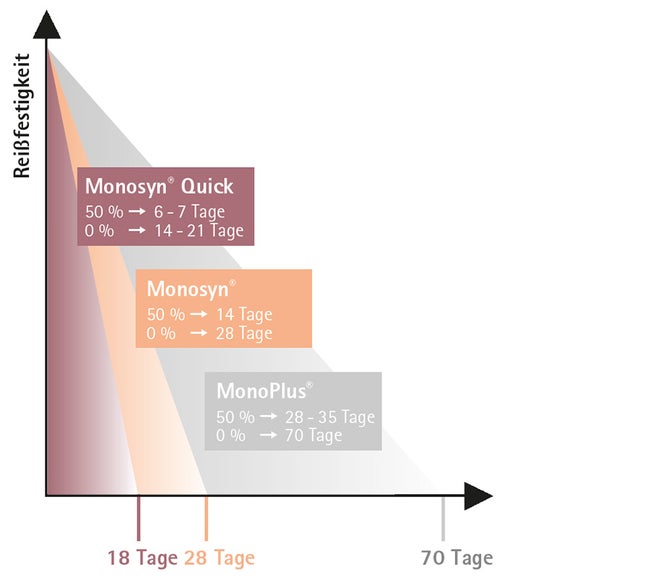Schnell und monofil
Monosyn® Quick ist ein kurzfristig resorbierbares und monofiles Nahtmaterial. Durch seine kurze Resorptionszeit wird Monosyn® Quick in der Tierarztpraxis und Tierklinik insbesondere in der Dentalchirurgie und für Nähte der Schleimhaut eingesetzt. Mit seiner guten Elastizität und Flexibilität in Kombination mit einer zuverlässigen Knüpfbarkeit ist Monosyn® Quick besonders gut für Wunden geeignet, welche nur eine kurze Unterstützung benötigen.
Indikationen
- Allg. intrakutaner Hautverschluss
- Gynäkologie, Urologie
- Dentalchirurgie
Eigenschaften und Merkmale
- Schnelle Resorption
- Zuverlässige Knüpfbarkeit
- Gute Flexibilität und Elastizität
- Einfache Handhabung
| Fadenaufbau: | monofil |
| Material: | Glykonat |
| Beschichtung: | keine |
| Metric: | 0,7-4 |
| USP: | 6/0-1 |
| Farben: | ungefärbt |
| Resorptionszeit: | ~ 6-7 Tage |
| Reißkraftverlust: | ~ 6-7 Tage 50 % |
| Materialresorption: | ~ 56 Tage |
Vorteile von monofilem Nahtmaterial
- Die monofilen Fäden fördern weniger Infektionen [1-4]
- Im Vergleich zu geflochtenem, polyfilen Nahtmaterial weisen resorbierbare Monofilamente einen geringeren Gewebewiderstand auf und reißen aufgrund ihrer glatten Oberfläche weniger ein [5]
Reißfestigkeit des synthetischen monofilen Nahtmaterials von B. Braun
Monosyn® Quick: Kurzfristig resobierbares Nahtmaterial für schnell heilendes Gewebe.
Monosyn®: Mittelfristig resorbierbares Nahtmaterial für die Approximation von Weichgewebe.
MonoPlus®: Langfristig resorbierbares Nahtmaterial für langsam heilendes Gewebe.
B. Braun bietet ein umfassendes Portfolio synthetischer resorbierbarer Monofilamente an.
Zugehörige Services und Informationen
Zugehörige Dokumente
[1] Mangram AJ, Horan TC, Pearson ML, Silver LC, Jarvis WR. Guideline for Prevention of Surgical Site Infection, 1999. Centers for Disease Control and Prevention (CDC) Hospital Infection Control Practices Advisory Committee. Am J Infect Control. 1999;27(2):97-132.
[2] Choi HJ, Chae HD. Comparison of E. Coli infiltration between new synthetic absorbable sutures. J Korean Surg Soc. 2009;77(1):1-6.
[3] Buresch A, Van Arsdale A, Ferzli M, Bernstein P, Garry D, Ngai I. Comparison of subcuticular suture type in post-cesarean wound complications: A randomized controlled trial American Journal of Obstetrics and Gynecology. 2017;216:1 Supplement 1 (S25).
[4] Won H-S, Lee S-W, Kim Y-M, Kim A. Clinical usefulness and safety of the anti-bacterial coated multi lament suture (Vicryl Plus®) and mono lament suture (Monosyn®) in hysterectomy BJOG: An International Journal of Obstetrics and Gynaecology. 2012;119 SUPPL. 1 (44)
[5] Im JN, Kim JK, Kim HK, Lee KY, Park WH. Characteristics of novel monofilament sutures prepared by conjugate spinning. J Biomed Mater Res B Appl Biomater. 2007;83(2): 499-504.



